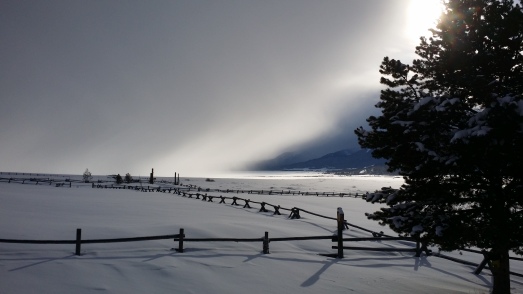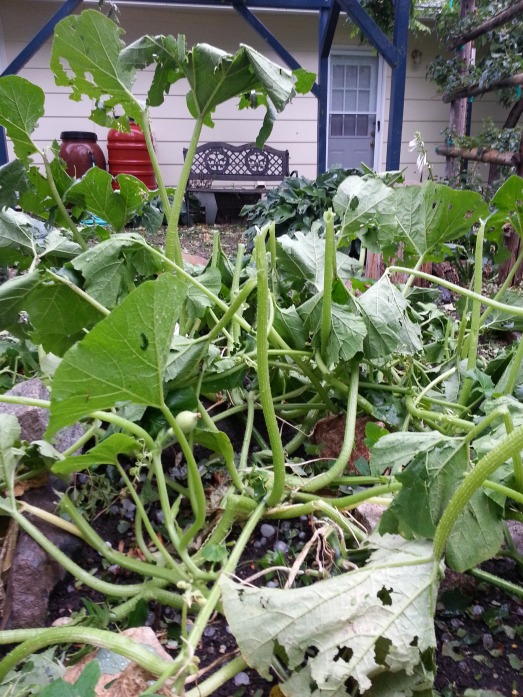This is the kind of question I understand repulses most people but for some reason fascinates me. It’s not so much about dying…I think…as it is about transitional zones in general. For me, they’ve always been the place where everything interesting is going on.
I ask the same kind of question when I’m lying around up in the mountains and watching the sun set…at what point does it turn from daytime into twilight and then into night? Or standing on a beach and watching the waves roll in and out…where are the lines that define where land becomes coast becomes sea?
Where do the colors really change on a rainbow, or is there an exact moment when a marriage fails, or at what length of tail can you stop calling it a tadpole and start calling it a frog?
These kinds of questions have always struck me as important even though I’m not entirely sure why. Maybe they give me a way to puzzle through the nature of change and the necessity for it? Or perhaps it’s because I’m not very good with loss and transitional zones all involve losing one thing as it changes into something else? Maybe I think about it a lot because I’m still trying to learn how to say good-bye, let go, and look forward again?
Or maybe it’s just how I was born. I mean, really. Who knows why any of us are fascinated by the things that we are?
But back to the original question, when exactly does dying start?
I used to unconsciously believe that it started when a doctor said that it did. At that stomach sinking, deer-in-the-headlights moment when a person was told, “I’m sorry. There’s nothing more we can do.”
Did anyone else think that’s when it starts? And that everything that happens before that horrible moment…all the whirlwind of treatments and waiting and bad news and worse news and more treatments and uncertainty and all the fear…is still living?
That’s what the journey of dying looks like so often these days. Plunging into diagnosis and treatment can be so much like being caught up and tumbled in a huge, breaking wave that scrapes you along the bottom and nearly drowns you before finally washing you up on shore, beaten, battered, and gasping…only to be told that now you’re going to die. Honestly, thinking about it like that absolutely terrifies me. I’m not all that worried about dying but I’m petrified of being over-treated for it.
But anyway, once I started to consider the question, and once I realized what my default answer was, I started observing more closely what was going on in my work and eventually discovered a couple of things that helped reshape my answer and ease that scary feeling a lot:
1) In hospice I learned about a thing called “active dying.” It’s when the body starts to go through the final shut-down sequence…when you get what’s called a “cascade of organ failure.”
(For the record, I really dislike that term. Watching a body shut down never looked like failure to me. On the contrary, it looked like a brilliantly…BRILLIANTLY…conceived protocol designed to both protect us from further horrendous suffering, as well as extract us from a clump of physical matter that’s starting to break back down into it’s essential elements for future life. To me, active dying looked just as miraculous and sacred and wild as birth ever did.)
The period of active dying is relatively short, lasting from a couple of days to a few hours and, in my evolving understanding anyway, became the clearest definition of when dying actually starts.
I have to admit, that conclusion really surprised me. It turned a lot of the standard cultural view I grew up with on it’s head. It even messed with the entire basis for referring a patient for hospice care in the first place, as they’re supposed to be dying to qualify.
And yet, it also explained something that hadn’t made sense up to that point. When I first volunteered with hospice I thought I was going to work with “the dying.” And yet I quickly discovered that the extraordinary people I was meeting were actually living. Times ten. In fact, probably more than most of the not-dying people I knew. I quickly surmised that I’d been laboring under a misperception, but it wasn’t until I finally figured out that dying doesn’t start until the very end that the nature of that misperception became clearer.
So for me, in strictly physical terms anyway, dying starts when our bodies enter the “active dying” stage. And everything that comes before that, no matter how turbulent or ominous or final, is still living.
So when a doctor delivers that terminal diagnosis…we’re still living. And when we get referred for hospice care…we’re still living. And when we start losing our appetite, energy, and bowel control and maybe can’t even get off the bed, I’ll be danged if we’re not STILL living. Maybe in a period of uncomfortable decline which is a definite bummer, but bummers have always been a part of living, too. So, so what?
And that was the second thing I figured out which helped ease that scary feeling.
2) Life and death, and living and dying, are completely different things.
Life and death are nouns. They’re things that exist as an independent fact, like cell division and tooth decay. They’re built into the system itself so they happen to us whether we deserve them or not/want them or not/appreciate them or not. First we’re dragged into life without any discussion and then we’re dragged back out again and, ultimately, we have zero power at either end. Granted, that’s a little unnerving but I still find the simplicity of it appealing. Turns out life and death are not…thank you God…something I have to try and control after all.
Living and dying on the other hand are verbs. They’re the smaller, more manageable ways that we get to participate in these vast and fundamental forces. Whereas we have no say whatsoever about life and death, we have enormous power over how we choose to live and die within them. How we choose to deal with them and face them (or not.) Depending on our inclination, we can turn either one into something meaningful, generous, and humbling or something ugly, painful, and degrading…or more likely a little of both. We are human.
In any case, that part of it is all up to us.
Which I love a lot because I need something to control. (As the hubster can testify.) I will happily give up trying to control life and death as long as I have living and dying to strap into the harness instead.
So back to the original question of when exactly does dying start, over time I’ve found it most useful to think of in birthing terms of all things. It goes kind of like this:
Life enters the world in in four stages; conception, pregnancy, labor, and delivery. From where I’ve been standing it looks like it heads back out along the same lines.
1) Conception, for me, would be the moment when I first realize I’m officially heading for the exit. This is it. I’m going to die. I think this one might be the hardest part.
2) Pregnancy would encompass most of the time I have left and would involve all the many and varied preparations required for death; wrapping up my life, finishing all the paperwork, giving and receiving any forgiveness, savoring all my “last times,” navigating all the tricks of a body in decline, saying my good-byes and thank you’s, making damn sure everyone knows how much I’ve loved them and, finally, making my peace.
3) Labor would be the briefest part and would constitute the active dying process.
4) And birth? Well, to be honest…it’s always kind of looked like birth is happening at both ends to me. If there’s one thing I’ve learned from studying all these different transitional zones over the years it’s that endings and beginnings are pretty much the same thing–a moment of conception. I know there are a lot of different theories out there about what’s going to happen after death…and I think they’re all pretty interesting…but I, personally, have no idea what the exact nature of my death/birth will be…and I like it that way. It makes it all seem like more of an adventure.
But I do know this; in all the time I spent in the rooms of “the dying” I never once saw life itself destroyed. On the contrary, with each person’s passage I saw it becoming something more vast and measureless than I’d ever understood.
Here’s a photo I took in the Olympic rainforest that captures a little bit of that feeling for me. The physical part of it anyway. (Rainforests are like the transitional zone incarnate. Changing from one thing into another is all that ever goes on in there.) This is what’s called a “nurse log.” It’s when one of the old giants falls to the forest floor and magically becomes a raised and fertile world for countless new seedlings to begin their tiny lives. Nothing wasted, nothing destroyed…only transformed and renewed.

copyright Dia Osborn 2012





 Tired yet? But I have so many more. Sigh.
Tired yet? But I have so many more. Sigh. And the last is…well, we have no idea what this is. It’s a phenomenon we’ve only ever seen up at the cabin this once. It was a column of light that shot up unexpectedly from the setting sun. It was HUGE. The photo doesn’t capture that part. And most odd, lasting about two minutes from the time we first saw it.
And the last is…well, we have no idea what this is. It’s a phenomenon we’ve only ever seen up at the cabin this once. It was a column of light that shot up unexpectedly from the setting sun. It was HUGE. The photo doesn’t capture that part. And most odd, lasting about two minutes from the time we first saw it. Sorry for the enormous size of the photograph. WordPress changed the download media feature while I was gone and I haven’t figured out how to resize yet. As mentioned…dilettante.
Sorry for the enormous size of the photograph. WordPress changed the download media feature while I was gone and I haven’t figured out how to resize yet. As mentioned…dilettante. 









































